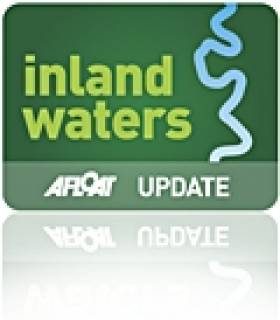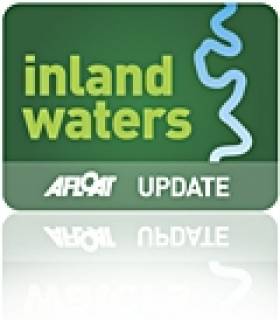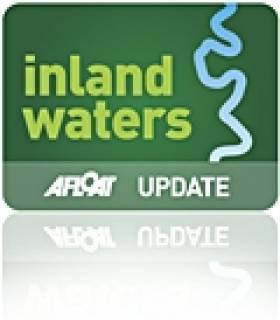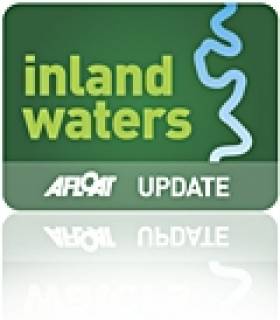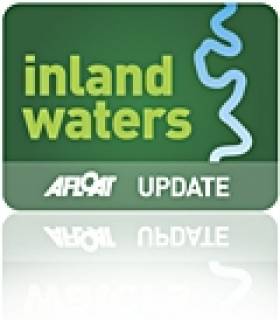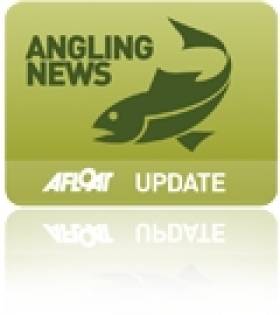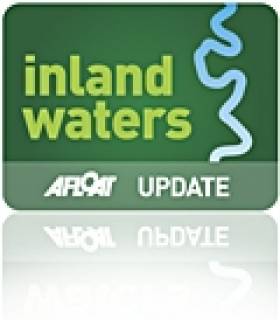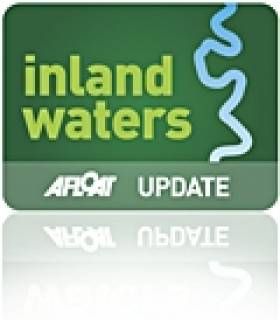Displaying items by tag: Grand Canal
The Grand Canal & The South Pole
Athy is not really a maritime town in the coastal sense of that description. Its marine connection is, essentially, the Grand Canal on Ireland's inland waterways linking Dublin to Limerick and which was extended to Athy in 1791 when it took 13 hours to get from there to the capital by boat. Canal passenger services began at the early hour of 5 a.m. on what was considered to be an expensive service.
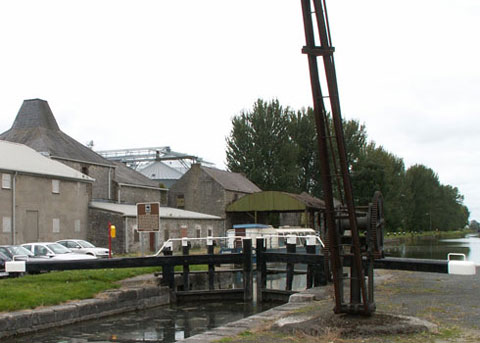 Athy on the Grand Canal
Athy on the Grand Canal
A Quaker writer, Mary Leadbeater from Ballitore near Athy, described passengers as ‘half gentry’ and noted that “there was card playing.”
There was worse than that in December of 1792 when five men, four women and two children died in an accident on a boat from Athy, blamed on “upwards of 150 people, many of them intoxicated, who forced themselves onto the boat in spite of repeated remonstrances from the Captain who in vain, told them the boat was overloaded and must sink if many of them did not withdraw. At length from their numbers and turbulence the boat was overset, near the eight lock,” reported The Freeman’s Journal.
Commercial trade on the Canal boosted Athy’s fortunes until the railway line from Dublin to Carlow forced the closure of business in 1846.
The Canal had been closed for 32 years when a child was born close to the village of Kilkea, between Castledermot and Athy, in the south of County Kildare, who would become a legend in Polar Exploration and lead to the town’s Heritage Centre-Museum having the only permanent exhibition anywhere devoted to that child who became the legendary explorer, Ernest Shackleton. Highlights include an original sledge and harness from his Antarctic expeditions, a 15-foot model of his ship, Endurance, an exhibition of Shackleton family photographs and an audio visual display featuring Frank Hurley’s original film footage of the Endurance expedition.
 Athy museum
Athy museum
The Shackleton Autumn School was established in Athy to commemorate the explorer. It provides a forum for discussion about Polar Exploration, about Shackleton and the presentation of relevant artistic work.
My main story in the current edition of my radio programme, THIS ISLAND NATION, is about Athy’s connection with Shackleton and the restoration of the cabin in which he died of a heart attack in the Antarctic on January 5, 1922 at Grytviken in South Georgia. The cabin is being restored at Letterfrack in Connemara. A Corkman, Eugene Furlong, initiated a project which is leading to its display at the Shackleton Museum in Athy. He located it during a visit to Norway. The restoration is being carried out at Conservation Letterfrack, where Janet O’Toole describes the work they will do. Joe O’Farrell of the Athy Museum Committee describes how they got the cabin back to Ireland.
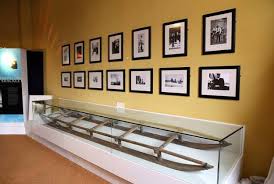 Shackleton sledge
Shackleton sledge
It’s a story of determination and achievement and how an Irish town has led the way in honouring the memory of Shackleton.
Also on the programme you will hear a somewhat remarkable sea shanty, about the Keeper of the Eddystone Lighthouse, his Mermaid friend and the family they conceived, believe it or not!
In serious vein, the RNLI and Irish Water Safety deliver the message of safety at sea, which should never be forgotten.
As always, there is plenty to report about the maritime sphere and I hope you enjoy this fortnightly programme.
Fair sailing
Talk On The Grand Canal In Offaly 1794-1804
#InlandWaters - Tullamore's Offaly History Centre will host a talk on Monday 23 March on the history of the Grand Canal in Offaly from 1794 to 1804.
Presented by James Scully, the talk will be based on various contemporary sources, most notably the invaluable records within the Grand Canal minute books.
Underwater Obstruction at Grand Canal, Sallins
#underwaterobstruction – Waterways Ireland is advising Masters and owners of vessels that there is an underwater obstruction in the Grand Canal at Sallins adjacent to the newly constructed extended mooring berths West of Sallin's Bridge.
Master's of vessels should navigate with caution until clear of the obstruction.
Waterways Ireland says it apologises to its customers for this inconvenience.
Grand Canal Towpath Closures In Dublin
#InlandWaters - The Grand Canal towpath in Dublin between the 3rd Lock in Inchicore to the 12th Lock in Lucan will be closed temporarily in various locations for different durations this spring.
The first of these closures are this week, with part of Section 3, between Park West Avenue and Ninth Lock Road, closed till this Friday 16 January, and Section 4 (Ninth Lock Road to the R120 at Adamstown) closed till Friday 30 January.
ESB Networks will be carrying out essential works on the electricity network until March 2015 on this route between the Naas Road and Grange Castle so check the South Dublin County Council website for the latest news.
IWAI & The Waterways of Ireland – New Book By Brian Cassells
#inlandwaterways – When English writer LTC Rolt made a round trip from the Shannon to Dublin in 1946, traversing the Grand and Royal Canals, he was considered an eccentric. In the 1940s commercial traffic on the canals and rivers of Ireland had dwindled to almost nothing. Rolt's notion that these waterways could be a source of joy to leisure boaters was considered pure whimsy. But it was the book Rolt published after this trip, Green and Silver, that was to act as inspiration for the formation of the Inland Waterways Association of Ireland (IWAI) in 1954.
There were other catalysts, too, that fired up the Association. The swing bridge at Athlone was to be replaced with a fixed span. The Royal Canal had already fallen into disrepair and was closed to navigation. Dublin Corporation proposed to lay a sewer along the Grand Canal and fill it in to make a road. The IWAI determined to oppose the authorities in their attempts to impede and close the network of waterways.
IWAI and the Waterways of Ireland is a celebration of sixty years of the Association doing just that. It begins with a rattle through the waterways themselves – the many rivers, lakes and canals. A short history of the IWAI follows, interesting as much for the names listed at the inaugural meeting as for what was achieved. Two of these were Colonel Harry Rice, retired from the British Army, and Sean McBride, dedicated Republican, politician and Nobel prize winner. Brian Cassells, writer and compiler of this book, comments 'I smile when I think of a dedicated Republican being best friends with a retired Colonel of the British Army.'
This fact says much about the compelling charm of boating in Ireland – it is a great social leveller. The portraits of people include George O'Brien Kennedy, boat designer; Syd Shine, showband leader; Rosemary Furlong, RNLI fundraiser; Jim McGarry, skipper. A diversity of people who were passionate about the rivers and canals, the boats and buildings.
The backbone of the IWAI remains the branches, and these are covered in full. It is the reasons for their creation, and the progress made, that make these descriptions come alive. How local opinion in Kenagh on the Royal Canal was certain it would never be re-opened (it was). Volunteers working on the Lagan Navigation clocking up 11,000 hours to restore Ireland's only flight of four locks. Coalisland branch members who possessed not a boat between them, dedicated to saving their canalside heritage.
The IWAI still has a campaigning role. There are notable successes in the book, given their own special pages – Ram's Island on Lough Neagh, the Royal Canal, and the Boyne Navigation. There is hope for the restoration of the Ulster Canal.
Brian Cassells has put together a book of immense charm, lusciously produced, rich in photographs. There is some repetition of facts, perhaps inevitable in a book with many different contributors. Nonetheless it is a valuable record of, and insight into, an organisation which has been instrumental in safeguarding a network of waterways that is among the most beautiful in Europe.
#InlandWaters - Waterways Ireland has confirmed that the construction project to develop houseboat mooring facilities for the Grand Canal in Sallins, Co Kildare has now recommenced on site.
It's now advised that as a consequence of the delay, which Waterways Ireland assures was unforeseen, the contract will now be completed in August.
Waterways Ireland says it "will ensure that the previous contractual difficulties do not result in any reduction in the quality or standard of the completed project.
"Waterways Ireland apologies to customers, residents and local businesses for any inconvenience caused by the unforeseen delay to the contract."
For further information please see Waterways Ireland's current Waterway Work Programmes.
Enquiries relating to the Sallins Houseboat Facility project are directed Waterways Ireland's on-site representative at 087 990 1935.
Angling Seniors and Juniors Spring Into Action
#Angling - The National Coarse Fishing Federation of Ireland (NCFFI) will host its annual Senior Canals Championship on the Grand Canal at Daingean, Co Offaly in two weekend's time on Saturday 3 and Sunday 4 May, just before the bank holiday.
Sponsored by Waterways Ireland, the championship and the biggest canal angling event of the year, attracting participants from all over the country and the UK who will be welcoming the warming inland waters with eager anticipation of some fantastic catches.
For more information see the NCFFI Facebook page HERE.
In other news, the River Erne in Enniskillen will be the venue for Waterways Ireland's Junior Angling Classic series, running over three successive Saturdays from 26 April.
Organised by the Erne Anglers Club in partnership with Waterways Ireland, NI's Department of Culture, Arts and Leisure and Fermanagh District Council, the series gives ing children aged 11 to 19 the change to test their mettle in competitive angling.
Fishing in Ireland has more details about the initiative HERE.
Boating Traffic on the Grand & Royal Canals & River Barrow to be Impacted By Bye–Laws – IWAI
Carmel Meegan, President of the Inland Waterways Association of Ireland (IWAI) welcomed delegates to the IWAI National Council meeting in Tullamore on 8th confirmed that the proposed bye-laws do not put user requirements, local communities or tourism at the centre of the regulations. Delegates heard –
In general –
there are reports that boats present this time last year have now left the Canals – the IWAI says this is indicative of boaters' fears and a further future drop in navigation use
Waterways Ireland have suggested that the 1800 plus submissions delivered by IWAI - during the brief consultation period of only 21 days- are letters in support of the IWAI
Submission rather than viewing these as other individual submissions recognising the effort and concern held by wider communities
Waterways Ireland imposed restrictions never previously invoked on boats travelling by Canal to the Dublin Rally in 2014 – which is celebrating 40 years of community activity
the proposed toll €75 to travel between the Grand and Royal Canals is detrimental – the IWAI advises this is the now most expensive boat crossing in Europe
the Newcomen lifting bridge will open only 8 times this year, only 96 boats are permitted to undertake the Green & Silver route around the Grand and Royal Canals this season due to restrictions of use of the Newcomen lifting bridge, significantly curtailing the emerging 'Green & Silver' route – the IWAI advises this is a major miss for domestic and international boat tourism.
Concerns aired as to the Canals and Barrow as a tourism resource have included questions in the Seanad and the Dail; County Council input; national and local press articles; television and radio interviews; community websites; blogs and Facebook pages reflecting overall national concern.
Politically, this has grown to be a very big issue and is featuring highly as politicians face into local elections this summer. The IWAI have gained the interest of local, regional and national
politicians on this matter to date, and will present our position to the Oireachtas Joint Committee on the Environment, Culture and the Gaeltacht in Leinster House on 25th
The boating community is not averse to appropriate management, facility provision, and access to waterways. But boats are key attractions, as the lifeblood of the navigations, and need to be welcomed.
#grandcanal – Waterways Ireland advises owners and masters that due to essential electrical and mechanical maintenance the Sea Lock at Ringsend (Buckingham Lock) is closed to navigation until further notice. This will prevent boat passage between Grand Canal Basin and the River Liffey whilst maintenance works are ongoing.
As works progress it may be possible to make passage by prior arrangement, but this will be entirely dependent on the stage of works. If wishing to make arrangement please contact the Dock Superintendent, Mark Clarke, on 087 258 4713, who will be able to advise accordingly.
Dublin Boat Passages on the Grand Canal to be Done in a Single Movement
#grandcanal – Waterways Ireland wishes to advise masters and owners that boat passages in or out of Dublin on the Grand Canal Main Line between Locks 1 & 12 should generally be undertaken as a single movement in one day.
A minimum of two working days' prior notice of intended travel is requested to be given to the Waterways Ireland Eastern Regional Office, to facilitate the necessary staffing assistance arrangements. To allow time for passage boats will only be permitted entry before 9:00am at either the Lock 1 or Lock 12 depending on direction of travel. This may be earlier depending on the number of boats making passage.
Please also ensure you have the following before making passage:
-adequate fuel on board
-competent and adequate crew to operate the boat and locks
(minimum crew of 3)
-a lock key on board your boat
-mooring lines of adequate length to handle vessel through a lock
(approx 15m length)
-no known mechanical problems with your boat
Boats will not be permitted to travel the system if their passage is considered to be unsafe by Waterways Ireland and / or if they do not have the appropriate permit.
Relevant Contact Details for Waterways Ireland, Grand Canal, Dublin:
Waterways Ireland Eastern Regional Office (M-F 9.30am-4.30pm)
01-868-0148
Dock Superintendent, Ringsend
Mark Clarke 087-2584713
Lock-keeper, Locks C1 to C7, Circular Line
Stephen Brierley 086-3805657
Lock-keeper, Locks 1 - 6, Main Line
Ray Moore 086-8278025
Lock-keeper, Locks 7 - 11, Main Line
John O'Brien 087-2683723
Lock-keeper, Locks 12 - 13, Main Line
Ray Moore As above


























